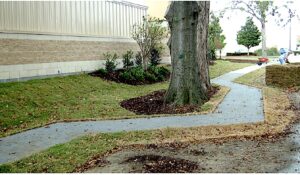Cities Using Rubber Sidewalks
New rubber sidewalks are going in around Kansas City
Kansas City residents in certain neighborhoods are walking on unbroken, tree root-free sidewalks this fall. The city’s Public Works Department is installing new sidewalks made from recycled rubber in select areas around the city.
It’s all part of the city’s effort to make the sidewalks last long in places where concrete sidewalks have struggled.
A study released earlier this year by the University of Missouri-Kansas City (UMKC) and sponsored by the city’s public works department analyzed costs and performance benefits of several alternative sidewalk materials, including recycled rubber.
“Public Works believes it is important to try new things and explore partnerships, activities and materials that improve the quality of our work,” the department said in announcing the sidewalk initiative.
Kansas City Mayor Quinton Lucas agreed saying, “It made a lot of sense to try different sidewalk materials because we’ve seen the same problem for years if not generations.”
The rubberized surface is especially helpful in neighborhoods like Waldo–one of the first to have rubber sidewalks installed—where big trees and big roots have caused damage to traditional sidewalks.
The rubber has enough “give” to it to allow the tree to keep growing, allow people to have a safe space, and allow better accessibility long term, Mayor Lucas said
 Rubber sidewalks increased flexibility makes them less likely to crack or break due to underground movement like shifting soil or growing roots, according to Rubberway rubber sidewalks manufacturer and installer of the city’s new sidewalks.
Rubber sidewalks increased flexibility makes them less likely to crack or break due to underground movement like shifting soil or growing roots, according to Rubberway rubber sidewalks manufacturer and installer of the city’s new sidewalks.
“Based on data generated so far, this application may potentially be used for around 4,000 trees throughout the city;” officials said.
The project doesn’t yet have a specific timeline, but some installations– like the one in Waldo –are already underway, city officials said.
“To be able to walk on the sidewalk up to the corner will be nice …. we were always in the street because the sidewalks were so broken,” one Waldo resident said. “This is a growing neighborhood and new sidewalks are really important,”
The city doesn’t yet have a specific plan for how many miles of rubberized sidewalks it intends to install. Currently, the project is based on areas where trees have caused damage to traditional sidewalks rather than specific neighborhoods
Officials said the city plans to use data from its 2019-2020 sidewalk inspections to determine where rubberized sidewalks might offer the best solution for trees and residents. In some areas only a small section may be rubberized to accommodate a tree, while other streets may see a whole block of rubberized sidewalk installed, they said.”
According to the city’s Public Works Department, if a tree is removed for sidewalk repair or replacement at a particular location, the City Forester’s Office will replace that tree with two new trees in that neighborhood, they said.
For the UMKC study, city crews installed a rubber sidewalk along one street block in the city’s Hyde Park neighborhood in 2021. The location was chosen in part due to several large tree roots that had cracked the existing concrete sidewalk in the area. After 18 months of observation, researchers reported positive results. “The test section had good performance at the time of publication,” they said.
California-based Rubberway which has a production facility in Springfield, Missouri, makes the sidewalk material the city is now using. These rubber sidewalks utilize recycled tire rubber to create a porous, flexible, safe, non-slip surface, helping to meet Kansas City’s performance goals, the company said. Because they are porous, the sidewalks allow water to drain through rather than pooling or freezing on top of them.
Rubberway Sidewalk is a two-layer system. The base layer, fabricated from post-consumer recycled tire rubber that is free of lead and heavy metals, is topped with a colored pure virgin rubber compound with UV resistance allowing for custom design options with a variety of colors to choose from.
In addition to Rubberway Sidewalks’ high recycled tire- derived material content , UMKC researchers cited its permeability to reduce winter ice build-up and ponding during rain, to allow water to infiltrate to adjacent tree roots, and allow evaporative cooling and reduce the urban heat island effect. The rubber sidewalks’ flexibility helps reduce joint wear and faulting where root heave occurs, they said.
UMKC researchers also studied environmental impacts in a one block test section of rubber sidewalk. However, the long-term environmental impacts of rubber sidewalks aren’t yet well researched, they said. While the study suggests that the rubber sidewalks can be slightly more expensive, Mayor Lucas points out they could prevent costs associated with removing or caring for trees that are harmed by more rigid sidewalk materials.
Sources: Kansas City DPW, Kansas City Star, KCTV
© Scrap Tire News, October 2023






